Travel the World Without Destroying It

Look with your eyes, not your hands. You were probably told that at some point growing up, as your eagerness to see and experience something new was checked by a wary adult. Humans now handle the Earth in a similarly precarious manner. Our desire to explore the world is increasingly plagued by an awareness that international travel harms the very places we spend so much to visit.
There are more commercial flights taking off today than at any other time in history. Many of them will take tourists to see the world’s most striking natural beauty. Snorkelling on the Great Barrier Reef, trekking in the Amazon, boat tours in the Arctic – cheap air travel has opened more of the world to tourism and ensured more people can afford to see it.
But it has come at a heavy cost to the planet. Aviation currently accounts for 2-3% of all annual carbon dioxide (CO₂) emissions. That may not sound a lot, but aeroplanes heat the atmosphere by up to three times more than their CO₂ emissions alone because they release nitrogen oxides – powerful greenhouse gases – and create contrails in their wake which trap even more heat in the atmosphere.
A single flight from London to New York is estimated to melt about 3.3 square metres of Arctic ice. Greta Thunberg – the campaigner who started the youth climate strikes – is making that journey to attend the UN annual climate summit in September. Rather than take a transatlantic flight and contribute to yet more ice melting, she’s sailing from Plymouth on a zero-carbon yacht.
Meanwhile, the aviation industry is predicted to double by 2040 – doubling the number of flights and the number of people taking them. Earth has warmed by 1°C since pre-industrial times and already many coral reefs are struggling beyond their thermal limits, while rainforests are drying out. Without drastic action, there may be little cause for exploring the world’s natural beauty in future, as there’ll be much less of it to see.
In this fifth issue of Imagine, we asked researchers to scan the horizon of air travel. Does the climate crisis demand we turn our backs on the skies and remain permanently grounded? Or could a technological breakthrough keep our travel obsessions afloat?
We’re flying towards the climate emergency
“Our house is on fire”, Thunberg said, as she addressed the World Economic Forum in January 2019. Few analogies capture the urgency of the climate crisis so succinctly. Political recognition of the crisis has been sluggish, but at the time of writing four countries have declared a climate emergency: the UK, France, Canada and Ireland. Worldwide, 935 local government bodies, which cover 206m people in 18 countries, have done the same.
In the UK, parliament voted to declare a climate emergency on May 1 2019. But less than a year before that, MPs voted by 415 votes to 119 to build a third runway at London’s Heathrow airport – already the largest single source of CO₂ in the UK. Had Britain’s parliamentarians suddenly realised their error a year on? More likely, they are like most of us who recognise the threat of the climate crisis but aren’t aware of – or would rather not think about – the scale of the change that’s needed to avert it.
That’s a problem that undermines many pledges to reduce emissions – and not just those made on the international stage. Within the towns and cities we live, councils commit to radical action in one breath while approving plans that will ramp up emissions in the next. The city council of Leeds recently declared a climate emergency and signed off on a strict carbon budget which commits the city to emitting no more than 42 megatonnes of CO₂ between 2018 and 2050. At the same time, the council has endorsed the expansion of Leeds Bradford Airport – promising new transport links and a commercial centre nearby.
Airport expansion – In 2018, four million passengers used Leeds Bradford Airport. With the expansion of the main terminal, the number is predicted to double to eight millioin by 2030.
Climate impact – All those additional flights would amount to more than double the 2030 target emissions for the entire city of Leeds.
Up and up from 2030? – If passenger numbers continue growing after 2030, even at a slower rate, emissions from Leeds Bradford Airport would overshoot the city’s carbon budget by a factor of nine by 2040.
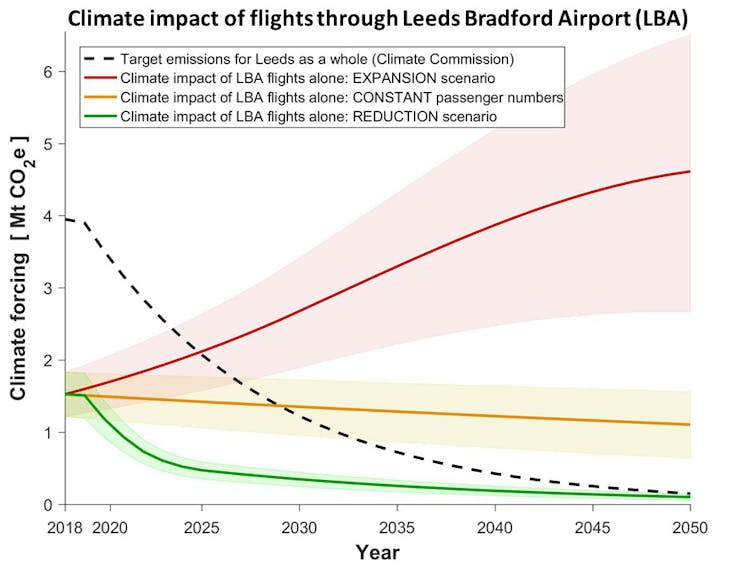
But even if the airport doesn’t expand and the number of passengers using Leeds Bradford remains at today’s levels, all flights between 2018 and 2050 would still consume the city’s entire carbon budget.
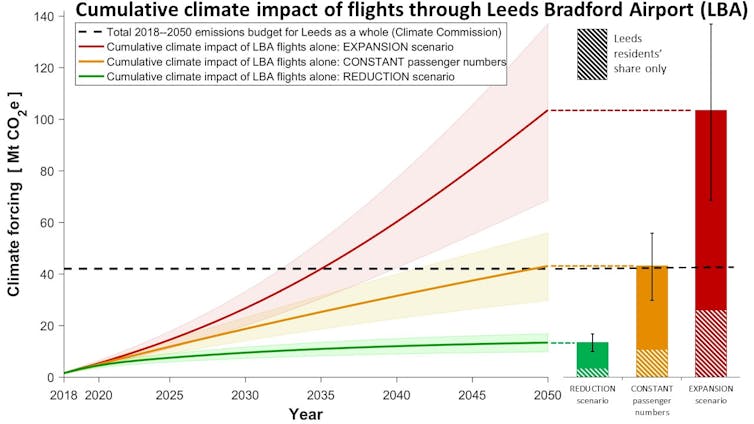
Only rapidly reducing the number of flights that take off from the world’s airports each year will lower emissions sharply enough to meet carbon budgets like that of Leeds, which are intended to limit global warming to 1.5°C at best. That could be done, say Jefim Vogel, Joel Millward-Hopkins and Yannick Oswald – researchers in sustainability and ecological economics at the University of Leeds – but we have to start right now. They said:
If cut in half by 2022 and 75% by 2030, the flights of Leeds residents alone would use up 8% of the city’s carbon budget. This might be just low enough to squeeze all other activities in Leeds into the remaining carbon budget – if these are also radically decarbonised.
How did we get here?
Airlines have proved wily in avoiding regulation. They are often totally omitted from emission accounting and aren’t subject to fuel taxes. But even when measures have been taken to rein in their emissions, they’ve often failed.
In Australia, a carbon price of A$23-$24 (roughly £13) per tonne of CO₂ was levied on flights between July 2012 and July 2014. This measure proved very effective at reducing emissions in the energy sector, but it had no detectable effect on the number of kilometres flown – and therefore CO₂ emitted – from Australian airports. Why?
An investigation led by Francis Markham – a research fellow in human geography at Australian National University – and Arianne C. Reis – a senior lecturer in leisure studies at Western Sydney University – found that a fall in ticket prices of 55% between 1992 and 2018 had eclipsed any cost increase from the carbon levy. Even when the cost was passed on to customers in full, the carbon price was too small to reduce demand as intended.
Airlines spend between 30 and 40% of all their expenses on fuel, and the cost of jet fuel has fluctuated wildly since 2005. When the carbon price came into effect in 2014, oil cost as much as USD$100 per barrel, but it fell to half that just a year later.
“Compared to the volatility in the cost of fuel, the carbon price was negligible”, Markham said.
Carbon prices work to decarbonise the energy sector because electricity generators can switch to solar or wind power which aren’t subject to the levy. But currently, cleaner fuels and technology to which the airlines might switch don’t exist on the same scale.
Instead, passengers might be dissuaded from flying with a frequent flyer levy which increases taxes in line with the number of flights a person takes. But this would be inherently unfair, argues Keith Baker, a research associate in sustainable urban environments at Glasgow Caledonian University.
Most plane passengers are already relatively wealthy. Only 18% of the world’s population have ever flown and in any given year, an elite 3% of the world flies. That’s about 230m people, but flights carried four billion passengers in 2017. So the average flyer takes eight return flights and aeroplanes rack up seven trillion air miles each year.
Frequent flyer taxes could price poorer people out of air travel while ensuring the richest can still afford flying to excess. Rationing the number of flights a person can take each year meanwhile would be much fairer, Baker says. This could work by setting an allowance of 500km for everyone to use in the first year of the scheme. If someone didn’t use it, their allowance would double to 1,000km the year after – and would continue doubling while it’s unspent.
People could bank their flight kilometre credits for a big trip, or trade them in for cash. If anyone exceeded their allowance, they could be fined or have their right to travel revoked for a period of time.

Rail against climate change
By restricting how much people can fly, the intention is to encourage them to use trains instead. Rail travel is a lower-carbon alternative to flying, but understandably, it’s not as practical for long distances. That didn’t stop Roger Tyers though, a research fellow in environmental sociology at the University of Southampton.
After pledging to go “flight-free” in 2019 and 2020, he won a fellowship to study Chinese attitudes to sustainability. That, unfortunately, involved field work in China, but rather than break his commitment, Tyers resolved to get the train from Southampton to Shanghai instead. He said:
The cost of the trains was over £2,000, dwarfing the £700 I could pay for a London to Beijing return flight. Time-wise, the train trip took just under two weeks each way. But in terms of carbon emissions my trip was a steal, contributing just 10% of the emissions of the equivalent flights.
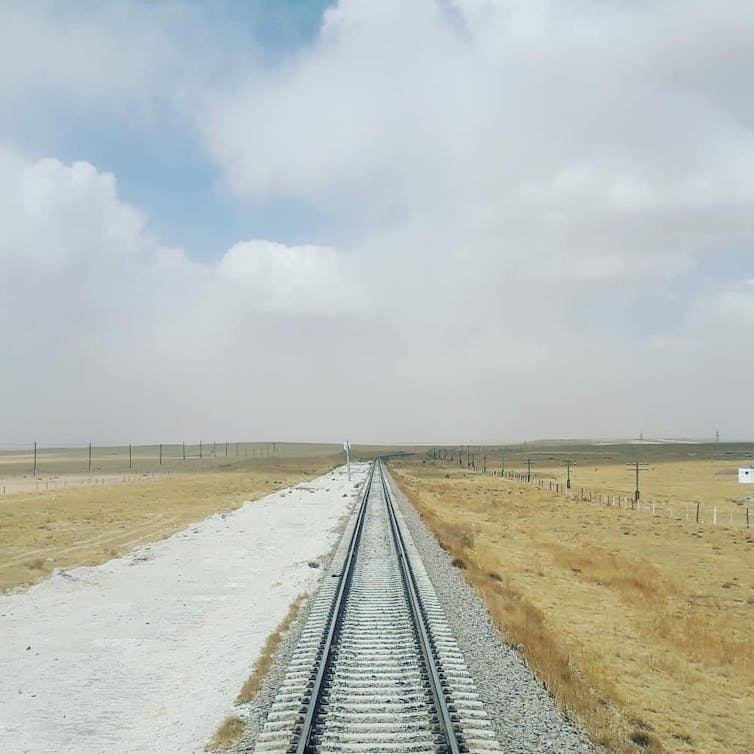
Greta Thunberg’s decision to abstain from flying is perhaps the most high-profile of such commitments. In her native Sweden, her example has helped cultivate a nascent taboo around air travel. Flygskam – or “flight shame” – was coined to describe the feeling that you’re pushing the world a little deeper into the climate crisis every time you book a plane journey. Already, it’s reported to have helped cut the number of passengers at Sweden’s ten busiest airports by 8% from January to April 2019.
Individual actions, though laudable, won’t drive a sufficiently large shift from air travel to trains on their own, particular when rail journeys are more expensive. Huge infrastructure changes and massive investment are needed to expand and improve mass public transport. With proper planning, Holly Edwards – a PhD researcher in low-carbon technologies at the University of Leeds – believes that high speed rail could replace many flights.
Planes versus trains – Out of the world’s top ten busiest air routes, all but one are domestic flights that could be replaced by rail journeys.
Faster by train – For many of these flight routes, such as São Paulo to Rio de Janeiro in Brazil, high-speed rail would be faster and emit between 75 and 97% less CO₂.
Global potential – There’s about 43,000km of high-speed rail currently operating worldwide and a further 55,000km planned for the near future.
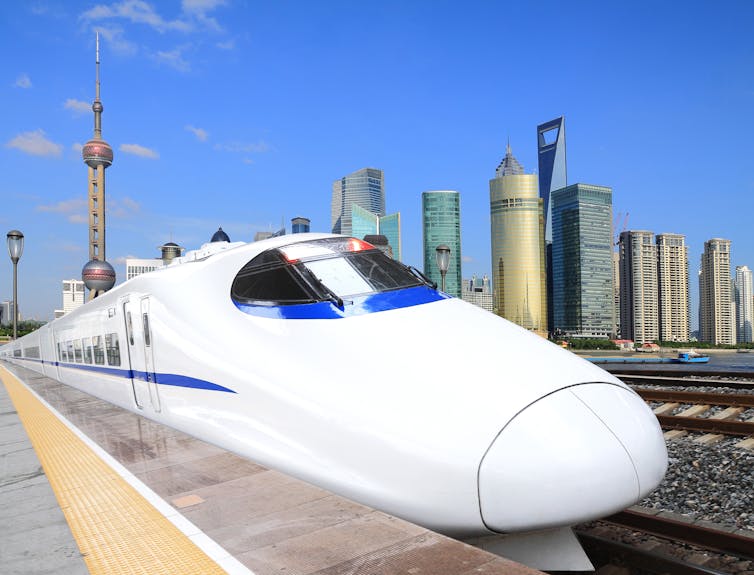
Flights of the future?
It’s now well over a century since humans first took to the skies in aeroplanes – a feat thought impossible by many right up until it happened. Are we due another revolution in human flight, one which powers air travel with zero-carbon technology? The great hope is that electric aeroplanes could oust the current fleet of commercial airliners which rely on fossil fuels.
Electric batteries are replacing combustion engines in road vehicles at such a rate that by 2030, electric cars are expected to make up one-third of the car market. Meanwhile, most electric aeroplane prototypes are grounded on the drawing board. Venkat Viswanathan, Shashank Sripad and William Leif Fredericks – all experts in mechanical engineering at Carnegie Mellon University in the US – believe it’s because batteries can’t store as much energy per weight as liquid fuels. This, they say makes batteries relatively heavy for aviation. As they explain:
Although the best batteries store about 40 times less energy per unit of weight than jet fuel, a greater share of their energy is available to drive motion. Ultimately, for a given weight, jet fuel contains about 14 times more usable energy than a state-of-the-art lithium-ion battery.
But a breakthrough could come sooner than expected. Alice, the world’s first all-electric commercial airliner was unveiled in Paris in June 2019. It carries nine passengers for up to 650 miles (1,040km) at 10,000ft (3,000 metres) at 276mph (440km/h) on a single charged battery. It’s expected to enter service in 2022.
Alice is still too small to carry the hundreds of people that most commercial flights manage today, but flying it is surprisingly cheap, according to John Grant, a senior lecturer in natural and built environments at Sheffield Hallam University.
The fossil fuel costs of small aircraft are about US$400 per 100 miles. For Alice, the costs are projected to be as little as US$8 for the same distance, and if the electricity is from renewable energy – perhaps generated by solar panels at the airport – then the plane could be zero-carbon.
Instead of waiting for mass electric air travel, Grant believes there are alternatives that could be built right now. Orbital rings sound like something straight out of science fiction, but Grant insists that the technology needed to build them already exists – all that’s missing is the ambition to do it.
An orbital ring is a steel cable that would surround Earth 80km above its surface. Connected to the ground by steel cables, which would also host passenger elevators, the ring could support two train tracks – one on its underside and the other on the outside – which would use magnets to propel trains without friction at great speeds above the Earth. Spun at the correct speed, the combined forces of gravity – pulling the ring towards Earth – and velocity would hold the ring in place, allowing passengers to reach the other side of the world in perhaps as little as 45 minutes.
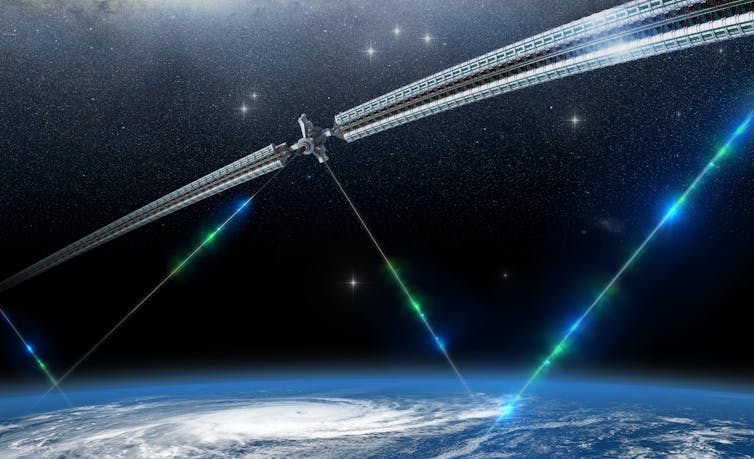
Sound far fetched? Well it’s no more crazy than letting the world descend into catastrophic climate change by not changing how we travel, Grant argues. He says we could actually return to a tried and tested method of flight that predates aeroplanes.
For as long as humans have taken to the skies we’ve had a low-carbon alternative to burning vast amounts of fossil fuels to keep us up there – balloons. The Hindenburg disaster may have condemned the industry to relative obscurity for almost a century, but it has never really gone away.
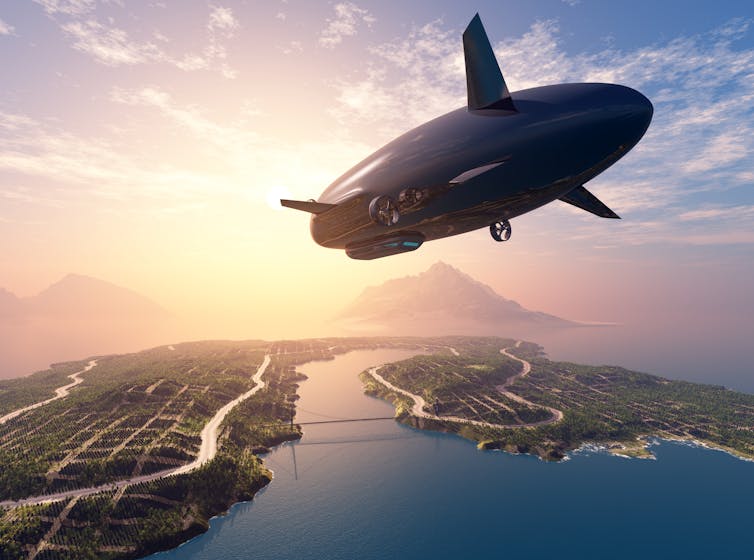
Safer fuels – the Hindenburg ignited due to its explosive hydrogen fuel, but modern airships use sacs of helium or safer forms of hydrogen which are cheap and relatively abundant.
Low energy costs – unlike jet aircraft, airships don’t need lots of energy to stay aloft. At that point, energy costs become comparable with rail travel.
Air cruises – airships are relatively slow, but they afford passengers stunning views of the world below. These “flying hotels” were originally designed to accommodate dining rooms and ballrooms.

Thunberg’s transatlantic crossing is expected to take two weeks, while the record from Frankfurt to New York by Zeppelin was 44 hours. Today people prize speed and convenience above all else, but the ongoing political awakening to the global climate emergency might finally herald a new age.
There are, after all, benefits to not being squashed into a metal tube and hurled across the world at high speed. For all those seeking a slower and less frantic pace of life, the retirement of hydrocarbon-powered aeroplanes could finally make the journey as satisfying as the destination.
Further reading
Climate change and air travel: why we have a responsibility to countries dependent on tourism
It’s time to wake up to the devastating impact flying has on the environment

Jack Marley, Commissioning Editor, The Conversation
This article is republished from The Conversation under a Creative Commons license. Read the original article.
